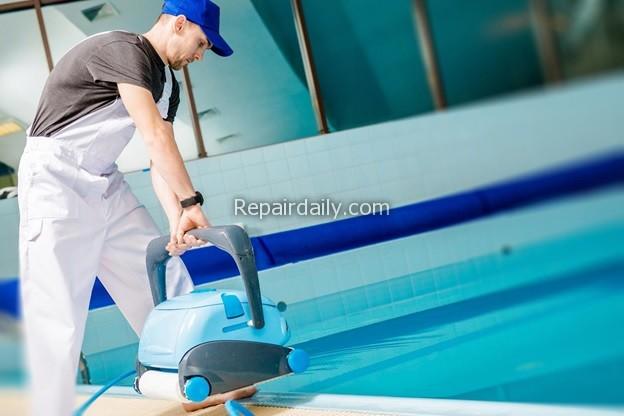
A good pool cleaner isn’t just for summer, taking time to clean and prep your pool now keeps water clear, protects equipment, and makes spring startup faster and cheaper.
Off-Season Care That Simplifies Spring Pool Cleaning
A pool that’s ignored over winter doesn’t just “get a little dirty”, it can quietly turn into a costly spring pool cleaning headache. Algae and bacteria thrive in stagnant water, and organic debris breaks down into phosphates (algae food). Metals in unbalanced water can stain plaster or pebble finishes, and scale can crust over tile lines and equipment. Unbalanced water can also etch plaster and grout; when pH drops, it dissolves calcium out of plaster, weakening the surface. Metal corrosion starts quietly, stainless ladders, heat exchangers, and pump shafts can pit if water gets acidic and sits stagnant.
By keeping the pool clean now, you’re protecting expensive finishes, avoiding heavy chemical treatments later, and extending the life of pumps and filters. Algae and bacteria don’t just stain, they form biofilms that protect themselves from chlorine; if left all winter, it can take 3-5x more chlorine and even an acid wash to kill them.
This is about protecting the pool as an asset (worth $40k), not just avoiding murky water. Think of it as preventative maintenance, an hour of care now can save days of scrubbing and hundreds of dollars in chemicals come spring pool opening.
Debris Removal Tips for Your Pool Maintenance Checklist
Don’t just scoop leaves and call it done. Before freezing temps, clear out organic debris like leaves, pine needles, acorns, and seed pods; they break down into phosphates and tannins that feed algae, lower pH locally, and stain plaster. Wipe away surface films, pollen, sunscreen oils, and early biofilm often cling to tile, steps, ladders, and waterlines and can harden or oxidize into stubborn stains if left all winter. Remove any calcium scale at the waterline with a pumice stone or scale remover before evaporation makes it worse. Vacuum fine silt and dust with robotic pool cleaner so it doesn’t settle into a nutrient-rich sludge that seeds spring pool cleaning, and empty skimmer baskets and pump traps to keep rotting debris from clogging or freezing. Doing this before you close means your pool cover won’t trap decay, and your pool maintenance checklist will pay off with dramatically clearer water when you open.
Balance Water Chemistry for Easy Spring Pool Opening
The off-season sweet spot is stable, not perfect, chemistry. Test and adjust so pH sits around 7.4-7.6 to minimize corrosion and scaling, with alkalinity at 80-120 ppm to keep pH from bouncing. Calcium hardness should be 250-300 ppm going into winter, cold water can pull calcium out of plaster, so this slightly higher range helps avoid etching or scale.
If you use chlorine, shock to 8-10 ppm before covering to oxidize organics and stop early algae growth, then let it settle to about 2-3 ppm for the rest of winter. This keeps water sanitized without overdosing and risking faded vinyl liners. Keep CYA (stabilizer) in check, ideally 30-50 ppm. If it’s higher from summer use of stabilized chlorine, drain and replace some water to bring it down so spring pool opening isn’t a battle.
Optional winter steps can help too: a copper-free polyquat 60 algaecide to prevent green water without staining, and borates at 30-50 ppm to lock in pH and make spring algae outbreaks far less likely.
Think of this as locking in balance, a few dollars in chemicals now can save you from draining, acid washing, or fighting mustard algae later as you work through your pool opening checklist.
Prep Filters and Pumps for Your Pool Opening Checklist
Backwash sand or DE filters and clean cartridges thoroughly; leaving dirty media all winter cements debris and shortens filter life. Open the filter tank to check internals now, cracked laterals, torn grids, or brittle cartridges are easier to replace before the spring pool opening rush. Drain water from the pump housing, remove and store drain plugs in the pump basket so they’re easy to find later, and lubricate pump lid and valve o-rings with silicone grease to prevent dry-rot and air leaks at start-up.
Clear skimmers by removing baskets, cleaning out gunk, and installing a skimmer gizmo or plug to prevent freeze cracks. For return lines in freeze zones, blow them out, loosen unions, and drain check valves so expanding water won’t split pipes or crack housings.
Flush heaters, check for critters, and brush off soot or corrosion. Remove automatic cleaners, clean them, and store them out of sunlight to keep hoses from cracking.
This step isn’t glamorous but can prevent cracked pipes, burned-out pumps, and frustrating surprises when you follow your pool opening checklist in spring.
Pool Cover Care for Your Saltwater Pool Opening Checklist
A neglected cover is like leaving the garage door open all winter. A sagging, leaf-covered cover lets organic material seep in, turning your pool into a swamp. Even small rips or gaps let in dirt and sunlight, fueling algae growth, just an inch of light can trigger a bloom. Standing water adds weight that can stress the cover, cause rips, and breed mosquitoes, so use a cover pump or siphon to keep it dry, especially if you don’t want to waste time adding salt again when you open the pool.
Keeping the cover tight and clean blocks light, keeps debris off, and prevents tannins from decaying organics from leaching through seams and staining the waterline. For vinyl covers, applying a UV protectant prevents cracking and can extend their life by two to three seasons, a small cost that saves hundreds by delaying replacement and helps protect your salt chlorine generator from having to fight unnecessary contamination when it’s restarted.
A well-kept cover means less refilling, rebalancing, and shocking a green mess come spring pool cleaning, especially if you’re planning a saltwater pool opening checklist for your next season.
Off-Season Checks to Avoid Costly Spring Pool Opening
Keep the water level just below the skimmer to prevent ice expansion damage, but not so low that the liner or plaster dries out. Mark the waterline monthly to catch slow leaks before they shift the liner or crack the shell; a quick walk around the perimeter after heavy rains can also reveal unexpected drops that signal leaks undermining soil.
If you run the pump in mild climates, make sure the freeze guard activates below 38°F and run the equipment for 15 minutes after a hard freeze to keep seals lubricated and ice from forming inside pumps. After big temperature swings, glance at plumbing, heater, and pump seals for cracks.
Check the cover every few weeks, tightening straps and removing heavy debris or water to avoid stress or collapse. Tap tile lines mid-winter; hollow sounds can reveal early bond failure from freeze expansion before tiles pop off.
These small habits help prevent surprise cracks, popped tiles, and collapsed covers, saving time on your pool maintenance checklist when spring pool opening comes.
Smart Tools to Streamline Your Pool Maintenance Checklist
A couple of smart tools and treatments can save you hundreds in repairs and chemical shock later. A mesh leaf net placed over a solid cover in fall keeps decomposing leaves out; remove it once trees finish dropping. A cover pump, ideally battery powered so it auto-starts when water collects, prevents standing water that can stress and rip covers.
For freeze protection, use skimmer gizmos or plugs, winterizing plugs, and antifreeze in plumbing. A pool air pillow can also relieve ice pressure on above-ground pools and some in grounds.
Enzyme-based clarifiers break down oils and gunk before they form stains or waterline scum, and a phosphate remover before closing strips out algae food to cut spring chlorine demand.
Accurate water testing matters too: a good digital test kit keeps pH and chlorine steady without over- or under-dosing, and a digital water monitor can alert you if chemistry drifts wildly mid-winter, so you don’t open to a black swamp during spring pool cleaning.
I'm so excited to tackle all my home improvement projects! From plumbing to DIY and cleaning - I'm ready to get down to work! #homerepair #homecleaning #plumbing #diy #fixerupper #realestate #renovation #interiordesign #farmhouse #diy #homedecor #hgtv #home #farmhousedecor #modernfarmhouse #farmhousestyle #fixerupperstyle #fixandflip #homerenovation #realestateinvesting #beforeandafter #homesweethome #remodel #realestateinvestor #interior #realtor #joannagaines #flippinghouses #countryliving #design #homedesign #farmhouseinspired #investmentproperty #bhghome #renovationproject #farmhousekitchen #homeimprovement #farmhouseliving #cottagestyle #decor #realestateagent #magnoliahome #homeinspo #magnoliamarket #kitchendesign #dreamhome #shiplap #construction #houseflipping #investor #farmhousedesign #architecture #farmhousechic #homereno #rusticdecor #reno #kitchenremodel #webuyhouses #magnoliatable #rentalproperty #fixerupperinspired #newhome #interiors #homeremodel




